After a complex restoration work pushed forward and realised by the Venice Gardens Foundation, chaired by Adele Re Rebaudengo, the Giardini Reali, covering an area of approximately 5,000 square metres adjacent to Piazza San Marco have now been returned to the city with the support of Assicurazioni Generali.
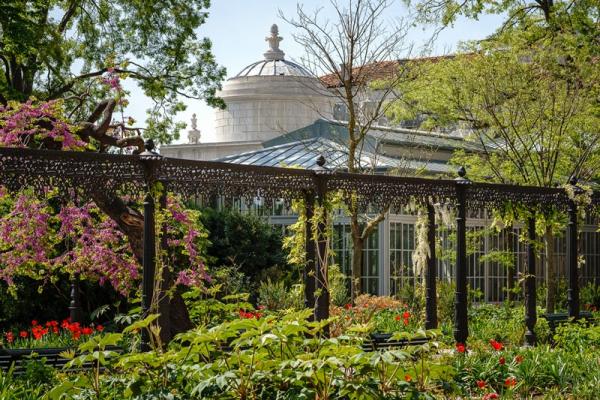 The restoration project involved the collaboration of many important professionals: the botanical project is the work of garden architect Paolo Pejrone, a pupil of Russell Page and Roberto Burle-Marx, while the architectural restoration and revival of the greenhouse was carried out by architect Alberto Torsello, based on the drawings of architects Carlo Aymonino and Gabriella Barbini.
The restoration project involved the collaboration of many important professionals: the botanical project is the work of garden architect Paolo Pejrone, a pupil of Russell Page and Roberto Burle-Marx, while the architectural restoration and revival of the greenhouse was carried out by architect Alberto Torsello, based on the drawings of architects Carlo Aymonino and Gabriella Barbini.
Venice Gardens Foundation is now managing the conservation and growth of the Giardini Reali in the long term, with its own professional figures and specific maintenance programmes, a synthesis of ancient knowledge and new techniques. A year and a half after their opening, the Gardens appear formal and luxuriant, as prescribed by the historic nineteenth-century design, and at the same time full of unexpected and surprising corners; once again a place in which adults and children can stroll, a place for reading, contemplation and recreation. 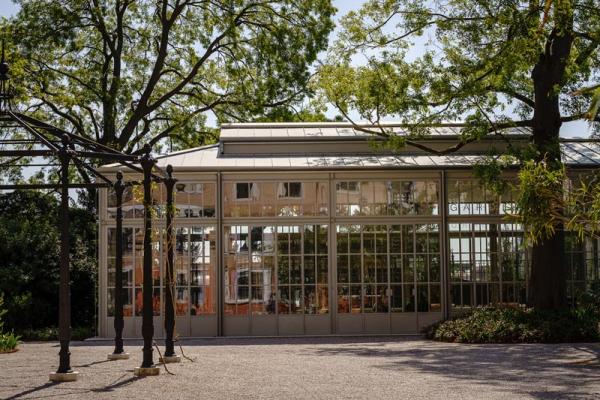 Thanks to the collaboration with LIPU, the Gardens have also become an oasis for the small birds of the Lagoon and for migratory birds too, which here can find an ideal place in which to stop and rest during their journeys.
Thanks to the collaboration with LIPU, the Gardens have also become an oasis for the small birds of the Lagoon and for migratory birds too, which here can find an ideal place in which to stop and rest during their journeys.
The restoration of the Gardens is an ambitious project, which can affect the perception of the nearby Piazza San Marco and the surrounding area. By restoring the garden, the neoclassical pavilion built in 1816-17 by Lorenzo Santi and the nineteenth-century pergola, by reconstructing the large and small greenhouses, and restoring the historic drawbridge, the Giardini Reali have recovered their beauty and their connection with the square, regenerating one of the most important areas of the city. The Venice Gardens Foundation hopes that this place can become, as it once was, a point of reference for the city’s residents, where they can find peace and beauty while strolling under the long pergola, among trees and flowerbeds, amidst a dense weave of textures and variations of greenery enriched by the colours of the seasonal blooms. 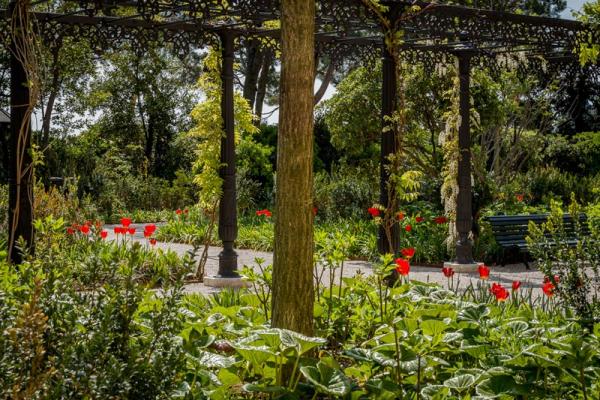 In springtime there will be the intense yellow of the Golden Harvest daffodils together with the orange-red of the Holland’s Glory tulips and the very special purplish-pink blossom of the cercis or Judas Tree; the creamy white of the fragrant Alba variety of wisteria and the deep purple of the double-flowered Black Dragon; the lavender-blue of the Dalmatica iris flanked by the elegant and showy Florentina iris; the striking yellowish-white masses of the pittosporum flowers and the Schablikine roses with their coppery pink seen against the background of the exuberant foliage of the tetrapanax papyrifer, which make the four central flowerbeds look like small exotic islands. During the summer, the blue and white of the spectacular flowering of the almost six thousand Agapanthus and Annabelle ortensias, the fruit of the fig trees and the scarlet red of the pomegranate blossoms prevail.
In springtime there will be the intense yellow of the Golden Harvest daffodils together with the orange-red of the Holland’s Glory tulips and the very special purplish-pink blossom of the cercis or Judas Tree; the creamy white of the fragrant Alba variety of wisteria and the deep purple of the double-flowered Black Dragon; the lavender-blue of the Dalmatica iris flanked by the elegant and showy Florentina iris; the striking yellowish-white masses of the pittosporum flowers and the Schablikine roses with their coppery pink seen against the background of the exuberant foliage of the tetrapanax papyrifer, which make the four central flowerbeds look like small exotic islands. During the summer, the blue and white of the spectacular flowering of the almost six thousand Agapanthus and Annabelle ortensias, the fruit of the fig trees and the scarlet red of the pomegranate blossoms prevail.
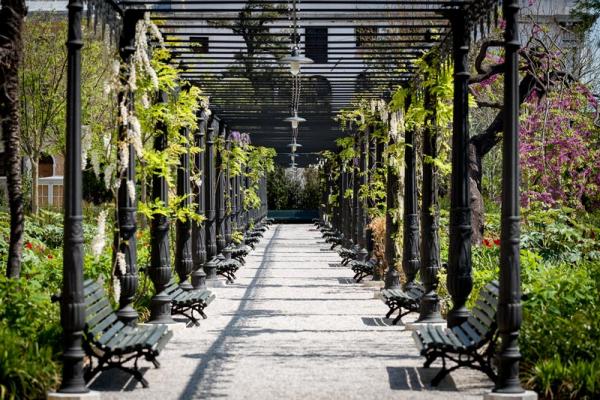 Adele Re Rebaudengo, president of the Venice Gardens Foundation, tells us: “following its vocation for the restoration and conservation of parks, gardens and heritage of historical and cultural interest, the Foundation works with passion and responsibility to develop and realise projects aimed at protecting the botanical and artistic heritage, recognising the fundamental role that these places play in a social and community context, as well as their ability to promote harmonious harmony between spirit and nature. These are deep-rooted values that I have personally held since childhood: I had the great fortune to grow up in a house with an old garden and over the years I have realised that this was a fundamental experience for me. I learned to listen, to look, to interpret and respect the elements of nature. I sought out and found that essential harmony, the most authentic dimension. I understood that it was a great privilege, but at the same time a great responsibility, so, when I finally had the opportunity to move to Venice, the city that I love most of all, I addressed my commitment to restoring the Giardini Reali to its inhabitants and visitors. It is a wonderful place that today has come back to life, a life that for too long was obscured”.
Adele Re Rebaudengo, president of the Venice Gardens Foundation, tells us: “following its vocation for the restoration and conservation of parks, gardens and heritage of historical and cultural interest, the Foundation works with passion and responsibility to develop and realise projects aimed at protecting the botanical and artistic heritage, recognising the fundamental role that these places play in a social and community context, as well as their ability to promote harmonious harmony between spirit and nature. These are deep-rooted values that I have personally held since childhood: I had the great fortune to grow up in a house with an old garden and over the years I have realised that this was a fundamental experience for me. I learned to listen, to look, to interpret and respect the elements of nature. I sought out and found that essential harmony, the most authentic dimension. I understood that it was a great privilege, but at the same time a great responsibility, so, when I finally had the opportunity to move to Venice, the city that I love most of all, I addressed my commitment to restoring the Giardini Reali to its inhabitants and visitors. It is a wonderful place that today has come back to life, a life that for too long was obscured”.
It has certainly been a complex, difficult project, requiring great dedication and tenacity, but at the same time an extraordinary experience that the Venice Gardens Foundation team tackled with great passion and enthusiasm: "We had the good fortune that all the representatives of the public bodies, the professionals, supporters, patrons and collaborators we dealt with were all of great value and professionalism, and all passionate about the project: everyone believed in and shared our vision.”
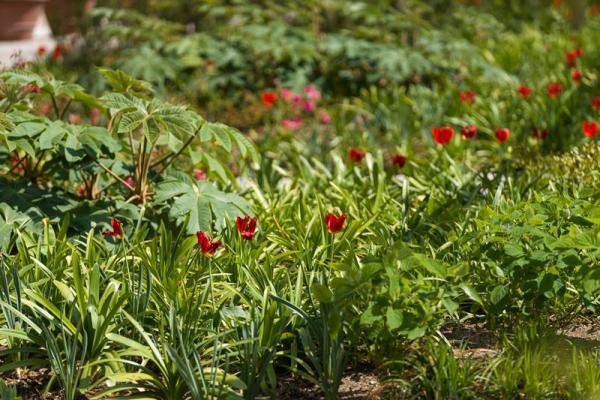 The rediscovered Giardini Reali are intended to be a space for meetings, activities and culture. Indeed, the Foundation has planned numerous initiatives, starting with the intervention of international artists invited to interact with the Gardens and create works “necessary for the life of the place”: Maria Thereza Alves and Jimmie Durham were the first guest artists. Photography is also involved in the rediscovery of the Gardens over time, with Guido Guidi, Francesco Neri and Carlo Soffietti called upon to interpret, document and narrate the evolution of this space.
The rediscovered Giardini Reali are intended to be a space for meetings, activities and culture. Indeed, the Foundation has planned numerous initiatives, starting with the intervention of international artists invited to interact with the Gardens and create works “necessary for the life of the place”: Maria Thereza Alves and Jimmie Durham were the first guest artists. Photography is also involved in the rediscovery of the Gardens over time, with Guido Guidi, Francesco Neri and Carlo Soffietti called upon to interpret, document and narrate the evolution of this space.
The restoration of the Giardini Reali is an initiative that contemplates a different way of experiencing Venice. As Adele Re Rebaudengo emphasises, "it is essential, and today more than ever, to pursue a ‘right measure’ in every aspect of living in the city, far from the dynamics of an overblown tourism; we should instead think of allocating major resources to the development of the production sector, to craftsmanship and, in order to encourage the residential sector, a vital element, to the recovery of public buildings, subsequently verifying their effective use. Venice must therefore find the way to cultivate intentions worthy of being collected, and to produce goods worthy of being distributed. A city with its own citizens”.
